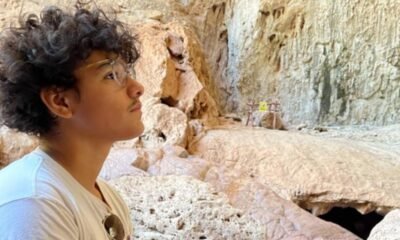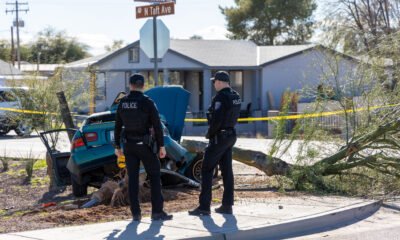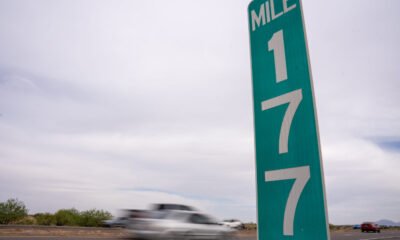crime
Tucson’s Roadside Memorials: A Poignant Tribute to Lives Lost and a Stark Warning to Drivers

In 2000, tragedy struck when Carmen Rios lost her life to a drunk driver on State Route 177 in Arizona. To honor her memory, her family erected a white cross at the site where she died, a poignant reminder that remained for 16 years until it was removed by the Arizona Department of Transportation (ADOT). The agency justified the removal by citing concerns for driver safety, prompting outrage from Rios’ brother, former Pinal County Supervisor Pete Rios.
Rios expressed his frustration directly to officials, questioning why ADOT would prioritize the removal of these memorials when pressing infrastructure issues, like potholes, needed attention. “Why are ADOT workers trampling over sacred ground?” he asked, lamenting the lack of consideration for families mourning their loved ones.
Growing up, Rios was taught by his parents to honor roadside memorials, reflecting on his childhood lessons that each cross marked a sacred site of loss. After discussions with then-ADOT director John Halikowski, Rios successfully negotiated a new policy permitting the continuation of roadside memorials under specific guidelines.
The revised policy stipulates that crosses must not exceed 18 inches in width and 30 inches in height, require wooden construction without photographs, and be placed in locations that do not pose hazards to motorists. Exceptions can be granted for long-standing memorials upon family request, recognizing their significance in the community.
Today, Tucson stands as the sixth deadliest city in the U.S. for motor vehicle crash deaths, with nearly 26 fatalities per 100,000 individuals reported in 2022. Disturbingly, it also ranks third for pedestrian fatalities, highlighting an urgent need for public awareness and safety measures.
In the wake of this alarming data, roadside memorials have proliferated across the city, offering both remembrance for lost loved ones and caution for drivers. They serve as vital reminders of the tragic outcomes of reckless driving and urge passersby to exercise vigilance on the road.
Alejandro Nava, a religious studies professor at the University of Arizona, views these public shrines as reflections of folk traditions that emerge organically from the community, apart from established religious practices.
“Roadside memorials symbolize hope and honor the memory of lost loved ones,” Nava commented. He noted how such observances resonate deeply within the cultural context of the Hispanic Southwest, where collective memories and practices surrounding death are openly expressed.
As Día de los Muertos approaches, many of these memorials transform into vibrant tributes adorned with flowers, candles, and sugar skulls. Meanwhile, in New Mexico, roadside memorials are legally recognized as “descansos,” or resting places, providing them with a certain level of protection.
The tradition extends beyond memorials for auto fatalities. Ghost bikes, white bicycles positioned to commemorate cyclists who have died in traffic incidents, began appearing in Tucson in 2008. Local restaurateur Ari Shapiro initiated this practice following the tragic death of a 14-year-old cyclist, ensuring that such memorials not only honor the deceased but also foster local awareness of cyclist safety.
In another poignant example, Rachel Lipari established a memorial for her husband Nick after his tragic motorcycle accident in 2020. Initially marked by a wooden cross, the memorial evolved into a cherished site of reflection and healing for his family. It has become a gathering place for remembrance and remembrance for anniversaries and birthdays, as well as a plea for greater caution from passing motorists.
Despite a truck crashing into the memorial recently, damaging some of the flowers, the spirit of remembrance endures. Lipari and her family continue to advocate for improved traffic safety measures, underscoring their commitment to honoring Nick’s memory while urging others to drive more safely.


















